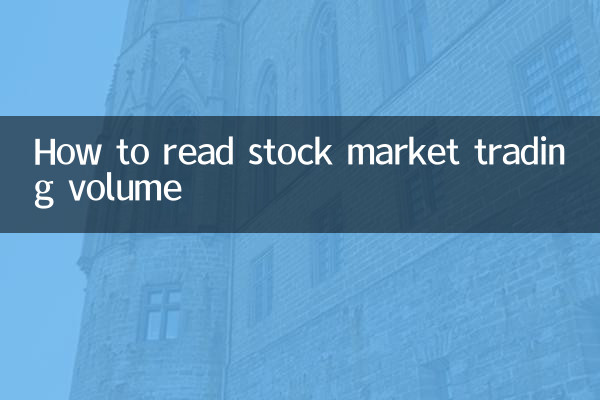How to read stock market trading volume
In stock market investment, trading volume is a very important indicator, which can reflect the activity of the market and the flow of funds. Whether it is short-term trading or long-term investment, the analysis of trading volume can provide investors with valuable reference. This article will combine the hot topics and hot content of the past 10 days to structurally analyze how to understand the stock market trading volume, and attach relevant data tables.
1. Basic concept of trading volume

Volume refers to the total number of shares traded within a certain period of time, such as a day, a week, or a month. The level of trading volume directly reflects market participation and capital activity. Normally, changes in trading volume are closely related to fluctuations in stock prices.
| Volume type | meaning | market signals |
|---|---|---|
| Increase the volume | Volume is significantly above average | May indicate trend reversal or acceleration |
| shrink | Volume is significantly below average | It may indicate that the market is on the sidelines or the trend is weakening. |
| equal amount | Volume is similar to average | Market sentiment is stable and trends continue |
2. The relationship between trading volume and stock price
The relationship between trading volume and stock price is an important basis for investors to analyze market trends. The following are several common volume-price relationships:
| Volume price relationship | market implications | Operation suggestions |
|---|---|---|
| Increase in price and volume | The upward trend is strong and funds are actively entering the market | Consider buying on dips |
| Price rises, volume shrinks | Lack of upward momentum and may peak | Be wary of callback risks |
| Price drops, volume increases | The downward trend accelerates and funds flee | Avoid blindly buying the bottom |
| Price drop and volume shrink | Downward momentum weakens and may stabilize | Pay attention to rebound opportunities |
3. Analysis of hot topics and trading volume in the past 10 days
According to the hot content on the Internet in the past 10 days, the following topics are closely related to the stock market trading volume:
1.AI concept stocks explode: The trading volume of AI-related stocks has increased significantly recently, and the single-day trading volume of some stocks has reached a record high, reflecting the market's strong focus on AI technology.
2.New energy sector adjustments: The trading volume of the new energy sector continues to shrink, and the trading volume of some leading stocks fell to the low of the year, showing signs of short-term withdrawal of funds.
3.Changes in heavyweight stocks: Heavyweight stocks such as finance and real estate have experienced intermittent heavy volume, but the stock price fluctuations are relatively small, which may indicate the adjustment of institutional funds.
| Popular sections | Changes in trading volume in the past 10 days | share price performance |
|---|---|---|
| AI concept | Average daily trading volume increased by 120% | up 25% |
| new energy | Average daily trading volume dropped by 40% | down 8% |
| Financial real estate | Single-day volume exceeds 30% | Slightly up 2% |
4. How to use trading volume to guide investment
1.Confirm trend: When the stock price breaks through a key position, if the trading volume is simultaneously amplified, the effectiveness of the breakthrough can be enhanced.
2.Identify reversals: When the stock price shows heavy volume and stagflation at a high level or heavy volume and stops falling at a low level, it may indicate a trend reversal.
3.Auxiliary timing: Combined with other technical indicators, seize the buying and selling opportunities when the trading volume changes.
4.Monitoring main force: Determine the trend of main funds by analyzing changes in large order trading volume.
5. Things to note in trading volume analysis
1. The absolute value of trading volume of stocks with different market capitalizations varies greatly, so more attention should be paid to relative changes.
2. Major good news or bad news may lead to short-term abnormal fluctuations in trading volume, which needs to be analyzed in conjunction with the news.
3. Trading volume may be distorted during special periods such as around holidays and earnings season.
4. There are differences in trading volume characteristics between emerging markets and mature markets.
6. Summary
Trading volume is the "thermometer" of the stock market. By scientifically analyzing changes in trading volume, investors can better grasp the pulse of the market. The recent explosion of the AI concept has once again verified the law of "quantity comes before price". It is recommended that investors combine trading volume analysis with fundamental research and technical indicators to form a more comprehensive investment decision-making system.
Finally, we need to remind you that trading volume analysis is only one of the tools, and there will always be uncertainty in the market. Investors should remain rational, strictly control risks, and avoid overreliance on a single indicator.

check the details

check the details